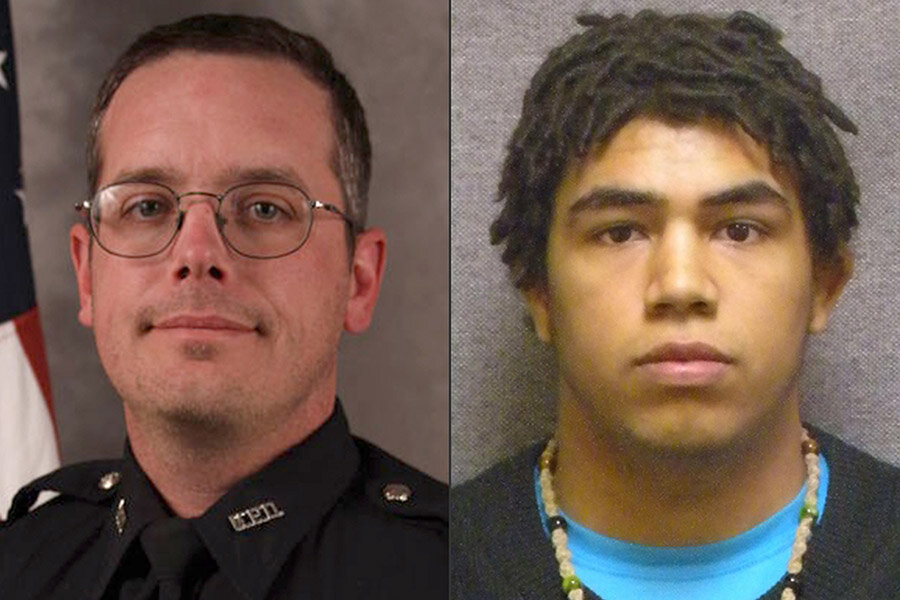Wisc. cop will not face charges in shooting death of unarmed black teen
Loading...
| Madison, Wisc.
A white Wisconsin police officer won't face criminal charges for fatally shooting an unarmed 19-year-old biracial man who witnesses say was acting erratically and had assaulted two people, a prosecutor announced Tuesday.
Dane County District Attorney Ismael Ozanne said he won't file charges against Madison Officer Matt Kenny in the death of Tony Robinson. Kenny shot Robinson on March 6 in an apartment house near the state Capitol building.
Police said Kenny was responding to calls that Robinson was running in and out of traffic and had assaulted two people, and Kenny was attacked when he entered the apartment house.
Ozanne spent some 25 minutes laying out the results of an investigation, citing three 911 callers whose accounts meshed with that from police. The callers described Robinson punching a friend, jumping in front of a car, punching one 911 caller in the face and assaulting two people on the sidewalk. One caller feared for both his safety and Robinson's, Ozanne said.
When Kenny reached the apartment building, he heard incoherent yelling, screaming, what sounded like a fist hitting something and items being thrown or breaking. Kenny thought Robinson was upstairs and might be attacking someone, Ozanne said.
When the officer ran in and upstairs with his weapon drawn, he announced his presence, and almost immediately was punched in the side of the head by Robinson, according to Ozanne. Kenny said he fell back on the stairs, and fearing for his life and the other person he thought was in the apartment if he had his weapon taken, Kenny seven shots in the span of three seconds, Ozanne said. Kenny was giving aid to Robinson when paramedics arrived, he said.
"I conclude that his tragic and unfortunate death was the result of a lawful use of deadly police force, and that no charges should be brought against Officer Kenny," Ozanne said.
Ozanne, who is biracial but identifies as black, stressed his own makeup before announcing his decision.
"I am the son of a black woman who still worries about my safety," he said. "I am a man who understands the pain of unjustified profiling and I am the first district of attorney of color not only in Dane County but in the state of Wisconsin."
He ended his statement with an implicit plea against violent demonstrations, saying "truth and lasting change does not come from violence, but from exercising our voices and our votes."
Robinson's mother, Andrea Irwin, said she was not surprised by the decision. She said the investigation wasn't thorough enough.
"They could have done a lot. What they didn't do was give my son any respect," she said following the announcement.
The city's black community mounted daily rallies for a week after the shooting. The protests were peaceful, although demonstrators had demanded Kenny be fired and charged with homicide.
The state Department of Justice investigated the shooting under a state law that requires outside agencies to lead probes into officer-involved deaths. The state agency handed over its findings to Ozanne on March 27.
The shooting was another in a series of police confrontations that have ignited racial tension across the nation in the past year, and the second such officer-involved death in Wisconsin during the period. Milwaukee Police Officer Christopher Manney, who is white, fatally shot 31-year-old Dontre Hamilton, who was black, during a scuffle in a downtown park in April 2014.
Manney also wasn't charged. The local district attorney, who is white, said Manney acted in self-defense, which sparked days of peaceful protests in the state's largest city. But Manney was fired for what Milwaukee Police Chief Ed Flynn said was improperly frisking Hamilton in the lead-up to the shooting. A police commission upheld the dismissal.
Most recently in Baltimore, riots erupted after the funeral for Freddie Gray, a black man who suffered a fatal spinal injury while in police custody. Other high-profile cases of officers killing unarmed black residents include the deaths of Michael Brown in Ferguson, Missouri; Eric Garner in New York City; and Walter Scott in North Charleston, South Carolina.
Six officers involved in Gray's death have been charged, as has the officer who killed Scott. Grand juries declined to charge the officers involved in Brown's and Garner's deaths.







